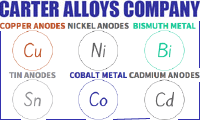
-----
Selectively Plating Out Copper Impurities in Nickel Plating Baths
We are running a POP process for exterior auto parts. Over the course of time our Cu baths build up a Nickel impurity caused by dragout from our Cu baths. The Ni baths are still usable and quite large so we are loath to change them out before we have to. To this end we have been trying to selectively plate out the Cu from our Ni baths using low voltage over an extended period of time (overnight or weekend). We are using stainless steel mesh 'baskets' to plate onto but so far we have been unable to get positive results. The baskets have good surface area and the voltage is kept at 1 but after 12 hrs we have black baskets but not a noticeable reduction in Cu impurities. Any ideas we could try to get better results?
Peter VigeantEngineer - Perryville, Missouri, USA
April 1, 2011
|
|
The standard is to use a "v" corrugated plate. I made mine out of a sheet of stainless steel. You would use a bit higher voltage. 1.5 to 2.0 is what I used. You can use spent acid to remove the ugly plating or with stainless, most of it will come off by beating the plate, since it was never activated. James Watts- Navarre, Florida Hi Peter, - Penang, Malaysia I would use a steel cathode(s) instead of a stainless steel cathode. Corrugated steel plates are typical. Calculate the total surface area of your cathode then set your rectifier at whatever voltage is necessary to achieve 2 amps per square foot of total cathode area.  Jon Barrows, MSF, EHSSC Kansas City Hi Peter,  David Shiu - Singapore |
I agree with the previous comments, but would add that good agitation is needed to bring the very dilute copper to the cathodes. Otherwise you will plate out mostly nickel. In badly contaminated baths, I've seen relatively pure copper plate out at the bottom of the corrugated plates. Since this seems to be an ongoing problem, you may need to do this continuously. Many platers do this in the overflow sump of the nickel plating tank.
Lyle Kirmanconsultant - Cleveland Heights, Ohio
April 6, 2011
Thank you for the prompt responses, they were very helpful. David, our concentration of copper is between 20-50 ppm right now but our testing method has recently been erratic (unrelated issue) so it could be as high as 100 ppm.
Peter Vigeant- Perryville, Missouri, USA
April 6, 2011
Further to the above suggestions I agree with the need for good agitation. 100 ppm is very high and you indicate that it is not going down, are you introducing at the same time as plating out? Check your anode baskets and parts on the bottom of the tank.
Suggest you have only slightly corrugated plate out sheets and deposit a coat of Nickel at normal cd first, then plate out at avg. 1-2 asf making sure that you are then plating out black to coppery plate, and every few hours raise cd to bind the deposit to the sheet in case you are dropping the plated out deposit back into the solution. If it is not black or coppery you need to change the current to get that effect (whatever the CD), don't waste good nickel.
Often sharply corrugated sheets plate out lots of good Nickel on the high CD points.

Geoffrey Whitelaw
- Port Melbourne, Australia
April 11, 2011
adv.: Supplier of Copper Anodes, Nickel Anodes, Bismuth Metal, & Other Metal Products for Industry & The Arts

Q, A, or Comment on THIS thread -or- Start a NEW Thread